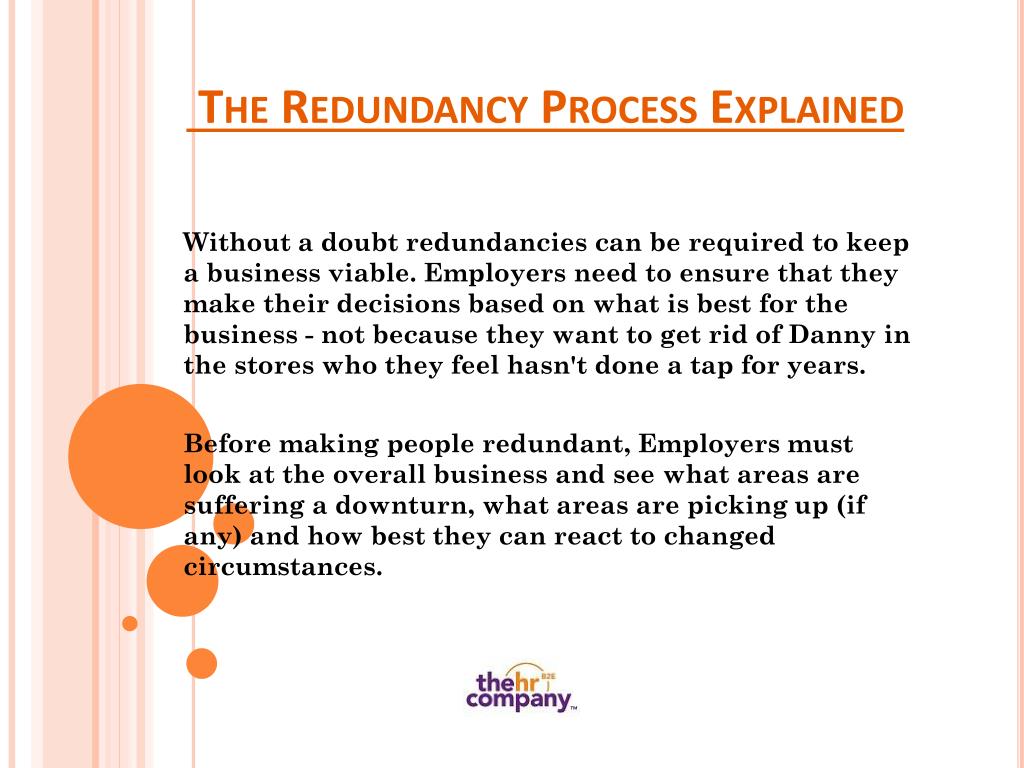Small Business Closing Employee Rights UK: Making Certain Fair Redundancy Pay
Small Business Closing Employee Rights UK: Making Certain Fair Redundancy Pay
Blog Article
Exploring the Operational Characteristics of Business Redundancy and Its Long-Term Sustainability

Redundancy Strategies for Service Connection
In order to make sure uninterrupted procedures, companies have to execute reliable redundancy strategies for organization connection. Redundancy in this context describes the duplication of important elements or features within a system to alleviate the impact of potential failings. By incorporating redundancy methods, companies can enhance their resilience versus disturbances triggered by different aspects such as natural disasters, devices failures, or cyber-attacks.
One typical redundancy approach is the execution of back-up systems and information storage solutions. This entails producing duplicates of essential information and systems that can be turned on in situation of a key system failing. In addition, organizations can develop repetitive interaction networks and power resources to preserve connection and procedures throughout unpredicted occasions.
Furthermore, cross-training staff members to execute numerous duties within the business can function as a useful redundancy method. If crucial employees are not available due to disease or other factors, this makes sure that essential tasks can still be carried out also. Generally, efficient redundancy techniques are necessary for organizations to maintain operational connection and minimize the influence of prospective disruptions.
Influence of Redundancy on Business Strength
Given the crucial role redundancy methods play in guaranteeing business continuity, exploring the impact of redundancy on organizational strength ends up being critical for understanding the holistic operational dynamics of a company. Redundancy, when tactically carried out, can substantially add to enhancing a company's durability in the face of unforeseen difficulties.
Furthermore, redundancy can strengthen employee morale and confidence, understanding that there are backup plans in place to deal with unpredicted conditions. This complacency can result in boosted efficiency and a much more positive job atmosphere. Furthermore, redundancy can promote advancement and creative thinking within a company as employees really feel encouraged to take calculated threats, recognizing that there is a safeguard to support them in case of failure. Generally, my site the impact of redundancy on organizational resilience is extensive, shaping the long-term sustainability and success of a firm.
Balancing Performance and Adaptability in Redundancy
Achieving a harmonious balance in between functional efficiency and flexible flexibility is an essential obstacle in the strategic implementation of redundancy within organizations. click here to read Also much flexibility without a solid operational foundation can result in ineffectiveness and incongruity.
To stabilize effectiveness and versatility in redundancy planning, companies should very carefully examine their operational requirements, market dynamics, and tactical goals. Inevitably, discovering the right equilibrium between performance and versatility is important for building a sustainable and resilient company in the face of uncertainty.
Long-Term Sustainability Through Redundancy Preparation
To make sure long-lasting practicality and security, companies must tactically align their redundancy preparation with long-term sustainability goals, thus integrating functional performance with adaptive versatility. Business must watch redundancy not as a reactive option to instant issues yet as an aggressive strategy for long-term success.

Proactive Procedures for Lasting Firm Operations
Exactly how can firms proactively enhance their operational sustainability for long-term success? Executing positive procedures is necessary for firms intending to make certain lasting operations. One crucial approach is to invest in technology and innovation to enhance procedures, lower waste, and remain competitive on the market. Taking on sustainable practices such as decreasing energy usage, decreasing carbon footprint, and enhancing source use can not just profit the setting but also lead to cost savings over time.
Additionally, fostering a society of continual renovation and discovering within the organization can boost versatility to changing market problems and consumer needs. Motivating employee participation in decision-making processes and providing chances for specialist development can enhance spirits, efficiency, and general efficiency. Establishing clear objectives, monitoring vital performance indicators, and consistently reviewing development are vital parts of positive sustainability administration.
Collaborating with vendors, customers, and various other stakeholders to promote sustainable techniques throughout the supply chain can produce a ripple impact of positive impact - redundancy pay if company goes bust. By taking proactive actions towards functional sustainability, companies can develop strength, drive technology, and protect their lasting success in an ever-evolving company landscape
Verdict

In the world of organizational management, the critical implementation of company redundancy stands as a pivotal yet intricate technique that necessitates a fragile equilibrium between functional effectiveness and long-term feasibility. By dissecting the functional dynamics that underpin company redundancy and reviewing its wider effects for organizational strength and adaptability, a nuanced understanding of how redundancy strategies can shape the future trajectory of a firm begins to unravel.Offered the critical function redundancy strategies play in making certain service connection, checking out the impact of redundancy on organizational resilience ends up being crucial for understanding the holistic functional characteristics of a business. On the whole, the impact of redundancy on organizational strength is profound, shaping the long-lasting sustainability and success of a firm.
In conclusion, comprehending the operational dynamics of firm redundancy is essential for making certain lasting sustainability.
Report this page